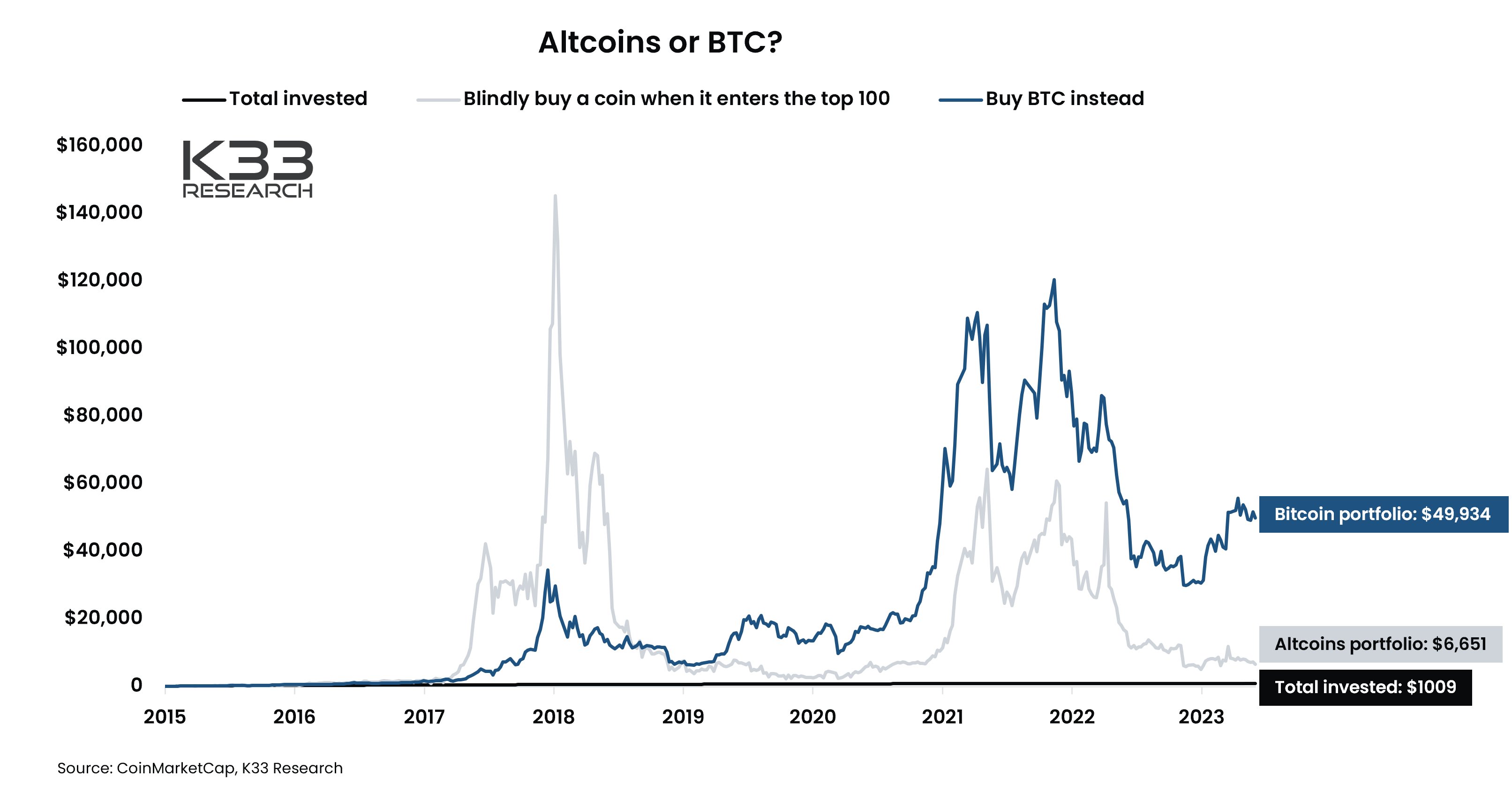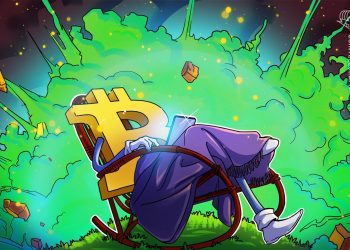Altcoins offer diverse, innovative features, promising technological advancements and potentially lucrative investment opportunities.
Các altcoin khác nhau có thể đạt được mức tăng vượt trội so với Bitcoin (BTC), đặc biệt là trong thời gian phổ biến ngày càng tăng, được gọi là các mùa altcoin. Tuy nhiên, phân tích từ K33 Research cho thấy rằng trong dài hạn, chiến lược đầu tư “chỉ có Bitcoin” đã mang lại nhiều lợi nhuận hơn so với danh mục đầu tư
Danh mục đầu tư altcoin kém hiệu quả hơn Bitcoin trong thời gian dài
Bitcoin đã có ba chu kỳ thị trường tăng và gấu liên tiếp kể từ năm 2013, với chu kỳ mới nhất là vào năm 2021. Trong mỗi chu kỳ, giá Bitcoin tăng theo hình parabol trong một khoảng thời gian ngắn gọn, thường là một vài tháng, sau khi vượt qua đỉnh của
Vào năm 2013, BTC đạt đỉnh khoảng 1.175 USD, tiếp theo là xu hướng giảm trong hai năm. Vào thời điểm đó, thị trường altcoin đang ở giai đoạn non trẻ. Các đường dốc fiat trên Bitcoin bị hạn chế và các sàn giao dịch mà các nhà đầu tư có thể chuyển đổi sang altcoin
Tuy nhiên, vào cuối năm 2015, một số altcoin đã xuất hiện, bao gồm cả sự ra mắt của Ethereum và đồng Ether (ETH) gốc của nó. Một số sàn giao dịch cũng đã được hình thành để hỗ trợ việc chuyển đổi Bitcoin sang các loại tiền điện tử khác, mở đường cho một thị trường altcoin
ãi đến tháng 4 năm 2017, khi giá Bitcoin vượt qua đỉnh năm 2013, một đợt tăng giá mới xảy ra giữa các altcoin. Trong nửa cuối năm 2017, sự bùng nổ cung cấp tiền xu ban đầu trên Ethereum và sự cường điệu đầu tư bán lẻ xung quanh XRP (XRP) của Ripple đã dẫn đến một mùa altcoin, với nhiều token vượt trội hơn Bitcoin cho đến
tháng 1 năm 2018.
Nevertheless, in the aftermath of the bull market, altcoins generally suffered greater losses than Bitcoin, suggesting the surge resulted from users buying them during Bitcoin bull markets with the hope of capturing higher returns.
Biểu đồ dưới đây cho thấy Bitcoin đã tìm thấy hỗ trợ quanh mức 6.500 đô la trong thị trường gấu từ năm 2018 đến 2019 sau khi phục hồi từ mức thấp 3.250 đô la vào cuối năm 2018. Tuy nhiên, tổng vốn hóa thị trường của altcoin tiếp tục dao động quanh mức thấp của nó trong hầu hết thời gian của thị trường gấu, chỉ đảo ngược xu hướng sau khi Bitcoin vượt qua mức đỉnh trước đó là

K33 Research đã tính toán hiệu suất đầu tư 1 đô la mỗi người vào 1.009 altcoin kể từ năm 2015 khi họ lọt vào top 100 theo vốn hóa thị trường trên CoinMarketCap so với cùng một số tiền đầu tư vào Bitcoin cùng một lúc.
Danh mục đầu tư altcoin sẽ có giá trị khoảng 7.000 đô la ngày hôm nay, so với 50.000 đô la từ chiến lược chỉ có Bitcoin.

Altcoins are usually narrative-driven, and many narratives die with the evolution of the market. For instance, privacy-based tokens were quite popular in 2017, but many have dropped out of the top 100 due to regulatory scrutiny.
Tương tự, nhiều mã thông báo tài chính phi tập trung đã xuất hiện trên thị trường vào năm 2020 – chẳng hạn như COMP của Compound (COMP) và RUNE của THORChain (RUNE) – đã bị loại khỏi các loại tiền điện tử hàng đầu theo vốn hóa thị trường do việc sử dụng DeFi giảm và nhu cầu nắm giữ các mã thông báo quản trị phi lợi nhuận.
Altcoin cũng chịu sự biến động và thay đổi không thể đoán trước, với sự không chắc chắn về quy định dao động trên hầu hết. Họ có thể trải qua các mùa altcoin riêng lẻ của họ vào các thời điểm khác nhau và thời gian có thể thay đổi đáng kể, đòi hỏi các nhà đầu tư phải có thời gian hoàn hảo để tạo ra lợi nhuận
K33’s analysts found that since 2015, over two-thirds of the 1,009 altcoin projects that managed to creep into the top 100 have become inactive. Only 9.11% of these altcoins yielded positive returns, with only around 1.5% outpacing Bitcoin’s 50x returns.

The report adds that altcoin investments were only profitable two times since 2015: in 2017, when Ether and XRP were outperforming, and in 2021, during the hype surrounding Dogecoin (DOGE) and Shiba Inu (SHIB).
Đáng chú ý, trong nửa cuối năm 2021, khi Bitcoin đạt mức cao nhất mọi thời đại mới ở mức 69,000 đô la, các altcoin đã ghi nhận mức tăng tương đối buồn tẻ, ngoại trừ ETH.
Positive breakout in Bitcoin’s dominance
Besides a breakout in Bitcoin’s all-time high, breakouts from crucial levels in Bitcoin’s dominance levels are another potent indicator that helps identify long-term trend reversals in altcoins.
Altcoin seasons during the previous two cycles were marked by Bitcoin’s dominance breaking below 60%. After the bullish trend reversal, the bottom in Bitcoin’s dominance also coincided with the top in the total market capitalization of altcoins.

If history repeats itself, Bitcoin’s dominance could rise further while altcoin performance remains subdued.
A breakout in Bitcoin’s dominance above the 50% level on June 19 — thanks to BlackRock filing for a Bitcoin exchange-traded fund — has opened room for further altcoin losses, as it marked a crucial historical resistance point.
In the latter half of the 2008–2022 bear market, Bitcoin’s dominance increased to over 70%. On the other hand, it performed relatively better, holding its price above the 2018 lows of around $3,250. K33 Research also shows that this period marked significantly poor altcoin performances, making new lows toward the end.
Related: Crypto industry ‘destined’ to be BTC-focused due to regulators: Michael Saylor
The K33 Research analysts added that while altcoin portfolios have shown the potential for greater profits than Bitcoin, they require “timing the market or picking the altcoin winners.” Anders Helseth, vice president of research at K33 Research, told Cointelegraph:
“You can create higher returns by trading market sentiment more aggressively, but it requires a lot of attention, and it is obviously more risky.”
Given that Bitcoin has outperformed altcoins over the long run, dollar-cost averaging (DCAing) into Bitcoin can be an effective investment strategy for crypto investors.
To DCA means to regularly invest a fixed amount of money into a particular asset over a specific period, regardless of the investment’s price, to average the principal amount and remove the need to time the markets. Helseth told Cointelegraph that DCAing is “a sensible, quite safe, simple crypto investment strategy.”
This article does not contain investment advice or recommendations. Every investment and trading move involves risk, and readers should conduct their own research when making a decision.
This article is for general information purposes and is not intended to be and should not be taken as legal or investment advice. The views, thoughts, and opinions expressed here are the author’s alone and do not necessarily reflect or represent the views and opinions of Cointelegraph.

























